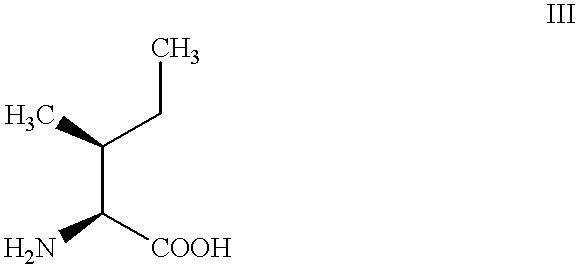Process for preparing D-alloisoleucine and intermediates for preparation
- Summary
- Abstract
- Description
- Claims
- Application Information
AI Technical Summary
Benefits of technology
Problems solved by technology
Method used
Image
Examples
examples
A. Production of D-Alloisoleucine from Epimer Mixture of L-Isoleucine and D-Alloisoleucine
Measurement of optical purities of the epimer mixture and D-alloisoleucine in the following examples was done with HPLC under the following conditions.
Column: Daicel CHIRALPAK MA(+) .phi.0.46 cm.times.5 cm
Mobile Phase: 2 mmol CuSO.sub.4 +MeOH (85:15)
Flow Rate: 0.5 mL / min.
Column Temperature: 30.degree. C.
Detector: Nihon Bunko UV-975, Wave Length 254 nm
example a-1
5 g (38.1 mmol) of an epimer mixture of L-isoleucine and D-alloisoleucine was suspended in 90 mL of water in an reaction vessel. To the suspension 6.83 g (19.1 mmol) of (2S,3S)-DBTA was added, and the mixture was heated to 70.degree. C. and maintained at this temperature for 1 hour under stirring. Slurry formed by reaction of the amino acids and the DBTA was allowed to stand still to cool, and subjected to solid-liquid separation at 25.degree. C. The solid obtained was rinsed twice with 10 mL each of water. 7.77 g of a 1:1-complex of D-alloisoleucine and (2S,3S)-DBTA was obtained as white crystal. Yield (based on the epimer mixture) as 41.7%, and the optical purity, 95.6% de.
The analysis of the resulting complex is shown below: Melting point: 175.5-176.5.degree. C.
IR KBr pellet (cm.sup.-1): 3156, 2972, 2942, 2882, 1733(s), 1692(s), 1601(m), 1528(m), 1320, 1266(s), 1118(s), 719(s)
.sup.1 H-NMR (270 MHz, MeOH-d.sub.4) .delta. (ppm): 0.97 (t, 3H, J=4.0 Hz); 1.00 (t, 3H, J=4.0 Hz); 1.24-...
example a-2
5 g (38.1 mmol) of the epimer mixture the same as used in Example A-1 was suspended in 49 ML of water in a reaction vessel, to which 1.98 g (19.1 mmol) of 35%-hydrochloric acid was added. Then, analogous to Example 1, 6.83 g (19.1 mmol) of (2S,3S)-DBTA was added to the suspension, and the mixture was heated to 70.degree. C. and maintained at this temperature for 1 hour under stirring. The same treatment as in Example 1 gave 8.21 g of 1:1-complex of D-alloisoleucine with (2S,3S)-DBTA in the form of white crystal. The yield (based on the epimer mixture) was 44.0%, and the optical purity, 96.2% de.
8.0 g of this complex was put in a mixture of 72 mL of 2-propanol and 8 mL of water to decompose the complex as done in Example 1. D-alloisoleucine thus obtained weighed 1.90 g. The yield (based on the complex) was 88.4%, and the optical purity (HPLC), 100% de.
PUM
| Property | Measurement | Unit |
|---|---|---|
| Electrical conductance | aaaaa | aaaaa |
| Electrical conductance | aaaaa | aaaaa |
| Substance count | aaaaa | aaaaa |
Abstract
Description
Claims
Application Information
 Login to View More
Login to View More - R&D
- Intellectual Property
- Life Sciences
- Materials
- Tech Scout
- Unparalleled Data Quality
- Higher Quality Content
- 60% Fewer Hallucinations
Browse by: Latest US Patents, China's latest patents, Technical Efficacy Thesaurus, Application Domain, Technology Topic, Popular Technical Reports.
© 2025 PatSnap. All rights reserved.Legal|Privacy policy|Modern Slavery Act Transparency Statement|Sitemap|About US| Contact US: help@patsnap.com



